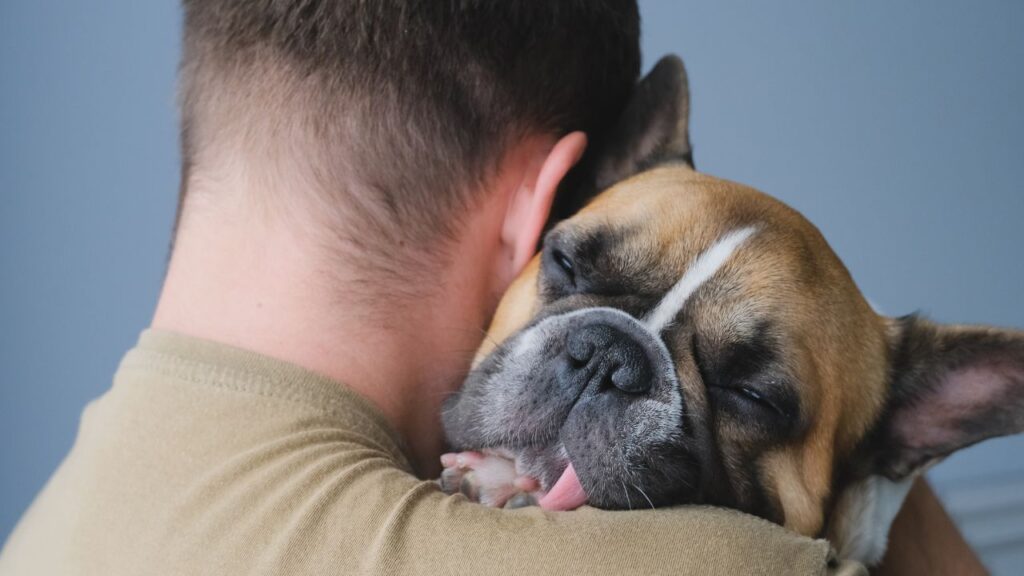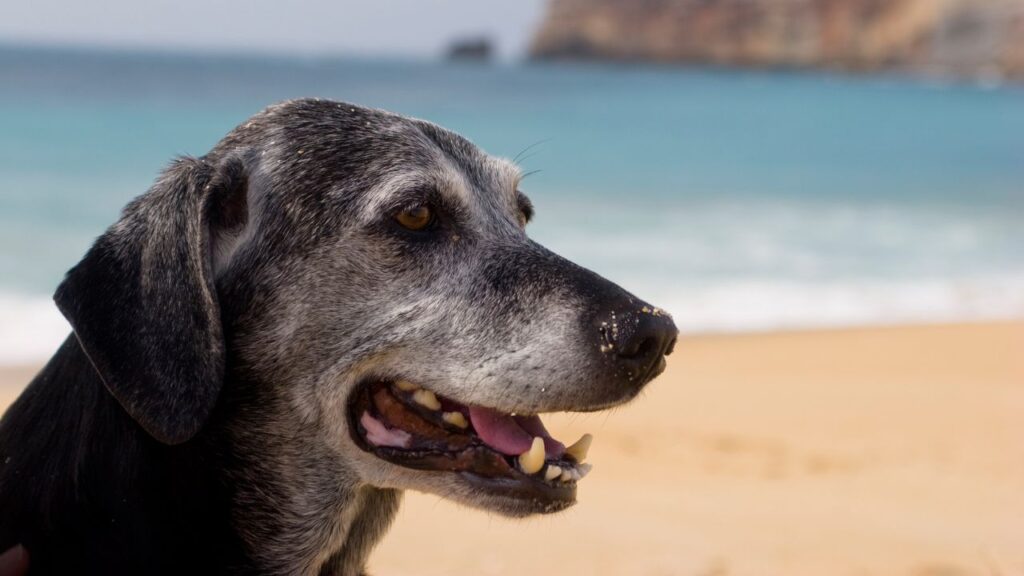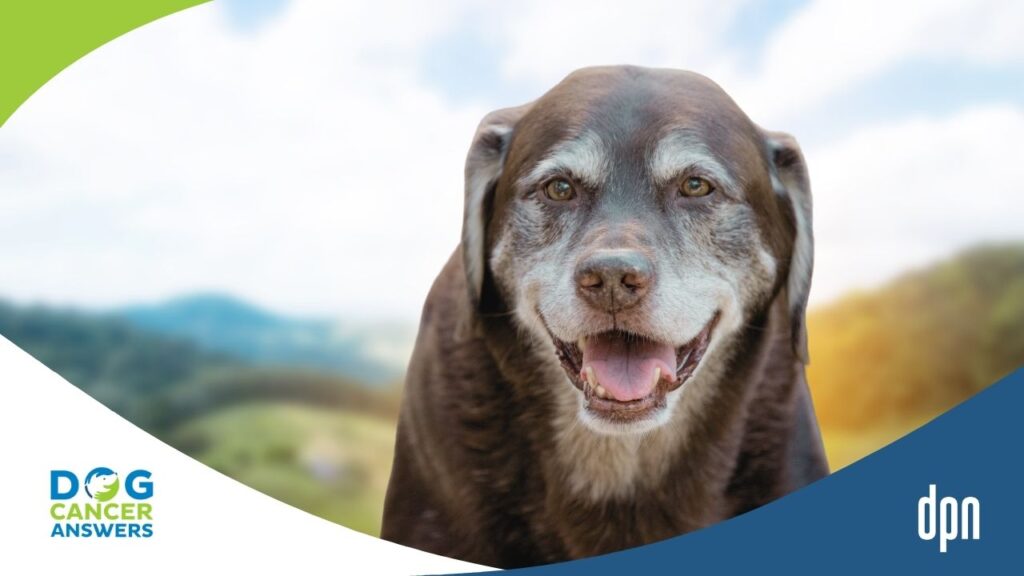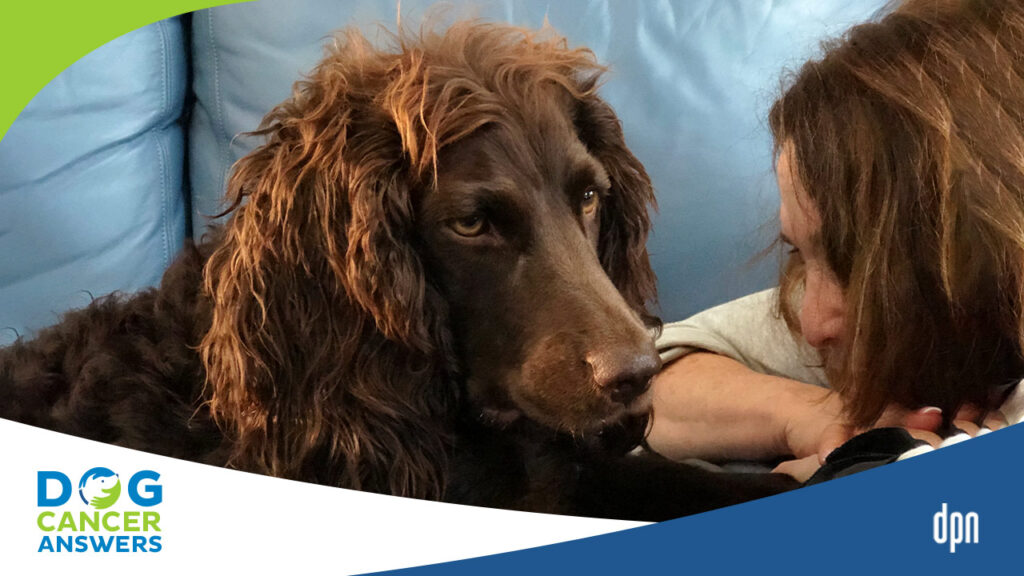[00:00:00] >> Molly Jacobson: Unless the cause of death is sudden trauma, dying happens over time, over months, not hours, not all at once.
[00:00:09] >> Announcer: Welcome to Dog Cancer Answers, where we help you help your dog with cancer.
[00:00:16] >> Molly Jacobson: Hello, dog lover. I’m Molly Jacobson, Editor-in-Chief at DogCancer.com. Here, over 40 veterinarians, veterinary oncologists, cancer researchers, and science writers, give you better information today, so you have no regrets tomorrow.
[00:00:32] Today, we’re going to discuss a very sensitive and emotional topic, recognizing the signs that your beloved dog might be nearing the end of their life. It’s really important to remember that any one of these signs might not mean your dog is actually dying. They might just need some medication or a treatment to get them through a rough patch.
[00:00:54] I’m not going to discuss things you can do in a lot of detail today. Instead, I’m going to provide links to articles and other podcast episodes that will help you understand the details in the show notes, so you can learn more as you need to about any given sign. Dying happens over time. Not all at once.
[00:01:14] Did you know that, that dying happens over months, not hours? It’s really true. Unless the cause of death is sudden trauma like being hit by a car, the body dies in stages. Depending on your dog and their unique illness, some signs might show up sooner than others, and some might not happen at all. So let’s begin with what you may start to see in your dog’s last three months of life.
[00:01:38] It could be two or one month of life, but sometime in the months before your dog’s natural death, you might see signs like, 1. Weight loss. Unexplained weight loss is a common sign that your dog’s body is not processing nutrition properly. A special diet might help, but you definitely need to call your veterinarian to get advice and monitor the situation.
[00:02:03] 2. Loss of appetite. A significant decrease in appetite or refusal to eat or drink. Most of the time might just mean they ate something they shouldn’t have, or that they’re in pain, which can make dogs reluctant to eat, but it can also be a sign that your dog’s body is beginning to shut down. Offer your dog food without making a big deal of it, if they don’t take it. And call your veterinarian to determine what the problem is and how to address it.
[00:02:32] 3. Dehydration. Hydration is critical to life, and in the last months of life, dogs often get dehydrated. Check by gently pinching the skin of your dog’s scruff. If it stays tented and doesn’t snap back, your dog may be dehydrated. Help with access to plenty of fresh water and call your veterinarian.
[00:02:54] 4. Diarrhea. Persistent diarrhea can dehydrate your dog and indicates a health problem for sure. Fast your dog for a while to give their system a rest and call your veterinarian if it’s persistent to get to the root cause.
[00:03:09] 5. Urinary incontinence. An inability to control their bladder is common in aging dogs and can indicate a short term problem, or general decline. Definitely, this is a time to call your veterinarian for help.
[00:03:23] 6. Vomiting. Frequent vomiting is dehydrating and can indicate serious health issues. Faster dog to begin with, but severe vomiting needs immediate veterinary attention.
[00:03:36] 7. Dimmed or dull eyes. Dog’s eyes can start failing at the end of life and they may seem to have trouble seeing. This could be an actual eye condition or just a sign of failing health in general. Don’t make assumptions and call your veterinarian.
[00:03:53] 8. Looking unkempt. If your dog isn’t practicing their normal hygiene by shaking themselves off and grooming themselves, they might look dull and dirty. Help them to stay clean with regular gentle baths and brushing sessions. Your groomer might have specific tips for your dog.
[00:04:11] Remember, any of these eight signs can occur individually, and they might mean your dog is just going through a rough patch. There are articles and podcast episodes about vomiting, diarrhea, loss of appetite, and many of the other signs that will give you more detail and ways to care for your dog.
[00:04:28] That said, the more of these signs that occur at the same time, the more likely it is that your dog has entered their own unique dying process. For every month we live. Our dogs live between four to seven months, so even though this goes by fast for us, it’s not as fast from a dog aging perspective. Now let’s look at the last weeks of life.
[00:04:52] One, two, and even three weeks before natural death, the signs we’ve already covered may continue, and new signs will also probably show up. Several of these are related to anxiety and pain. 1. Pain. Your dog may show signs of pain such as whining or avoiding touch. Call your veterinarian to address pain promptly because this is a huge life quality issue.
[00:05:18] 2. Restlessness. Restlessness, like pacing or constantly shifting positions, can mean your dog can’t get comfortable. This definitely indicates physical or emotional discomfort or pain. Again, call your veterinarian.
[00:05:33] 3. Behavioral changes. Sudden changes in behavior, like aggression or clinginess, usually means your dog is distressed or in pain. Your veterinarian needs to know about those behaviors.
[00:05:46] 4. Changes in sleep patterns. When your dog sleeps too much or too little, that can indicate health issues, including depression, anxiety, and pain. Your veterinarian can recommend treatments to help your dog be more comfortable.
[00:06:03] 5. Breathing problems. Labored breathing, rapid or shallow breaths, harsh breathing, or even very soft breathing, is an emergency. Even if the symptoms last for weeks and your dog is still walking around, it hurts to not be able to breathe well, so call your veterinarian.
[00:06:23] 6. Confusion. Your dog may seem confused or disoriented, which can be a natural sign of cognitive decline, but also due to organs shutting down. So again, call your vet.
[00:06:36] 7. Depression. Just like humans, dogs can experience depression, becoming withdrawn and less responsive to affection. This is upsetting for sure, but try not to take it personally and do take it seriously. If you think your dog is depressed, call your veterinarian.
[00:06:55] 8. Wanting to be outside. A dog’s natural instinct is to separate from their family when they know they are dying. This protects you from predators in the wild. Your dog might not want to come inside or might seek the outdoors more often. If you can let them be outside safely, let them stay there.
[00:07:17] I know it sounds like I’m telling you to call the vet a lot, but it’s crucial to involve your veterinarian sooner rather than later. They can help figure out whether these signs are treatable, short term issues, or if your dog is in fact in the dying process. Either way, your veterinarian is the best resource for comfort meds and care strategies. I’m going to collect my thoughts, and while I do that, let’s hear from our sponsors, and we’ll be right back.
[00:07:50] And we’re back. So, now, let’s look at the very last days of life when the organs start to permanently fail. Here are some signs you might see if your dog has days, not weeks or months left to live. If you see any of the following signs, especially more than one, it’s time to call the veterinarian to get their advice and help right away.
[00:08:15] 1. Lethargy. Lethargy, which is extreme tiredness and inaction, is common near the end of life. Respect their wishes and don’t pressure them to be active. If you can, just stay nearby or where they can hear you so they know you are there for them.
[00:08:34] 2. Lack of interest. A loss of interest in their favorite activities can indicate declining health. It’s definitely part of the natural process. There’s no need to push them. It’s time to let them rest.
[00:08:47] 3. Lack of coordination. Difficulty walking or moving can mean muscles aren’t getting the energy they need. If you think they can get outside to pee, help them with a towel or by carrying them, because most dogs prefer to relieve themselves outside if they can.
[00:09:05] 4. Twitching. Muscle twitches or spasms can indicate neurological issues as that system shuts down. Make sure your dog’s environment is safe and as soft as possible.
[00:09:19] 5. Weakness. Overall weakness and difficulty standing or moving, like dragging the hind legs, are signs of serious decline as muscles and nerves shut down. Carrying them might help as well as putting them in a soft bed with their food and water close by.
[00:09:38] 6. Inability to control bowel movements. A total loss of bowel control, not just diarrhea, but complete loss of all control can be a sign that the digestive organs are no longer working. Clean them up well to keep them comfortable and put down pee pee pads or towels for future accidents.
[00:10:00] 7. No eating or drinking. If the digestive organs have stopped working completely, your dog will not take in either food or water. A complete stop to all eating and all drinking is a serious sign that your dog’s body is shutting down. Don’t try to force them to eat at this point.
[00:10:22] 8. Seizures. Seizures can be a sign of severe neurological issues and require immediate veterinary attention. Move sharp objects and try to cushion them where they are so they don’t get hurt. If you can safely hug them as they seize, they will definitely appreciate your presence.
[00:10:41] 9. A puffy appearance. Swelling or a puffy appearance can indicate organ failure. Your dog may need pain and comfort support right away, so call your veterinarian.
[00:10:54] 10. Body odor. A noticeable change in body odor can indicate severe infections or organ failure. If your dog starts to smell really bad, it’s time to call your veterinarian.
[00:11:07] Now, each dog is unique and each death is unique. There may be other signs specific to your dog’s illness or condition that could signal death is close. Seeing any one or combination of these signs does not automatically mean your dog is dying. But please consult your veterinarian as soon as possible. Dying is a difficult and painful process and it only gets more so in the last stages.
[00:11:34] Getting them comfort and support is vital for life quality. Your veterinarian can take steps to help your dog be as comfortable as possible and also coach you on how to best be there for your dog as they step onto the rainbow bridge.
[00:11:52] That’s it for today’s show. Be sure to subscribe wherever you listen to podcasts so you don’t miss a future episode and check the show notes for lots of relevant links to articles and podcasts that will help you understand each of these signs more deeply. Take good care of yourself. I’m Molly Jacobson. And for all of us here at dog podcast network, I’m wishing you and your dog a warm Aloha.
[00:12:21] >> Announcer: Thank you for listening to Dog Cancer Answers. If you’d like to connect, please visit our website at DogCancer.com or call our listener line at (808) 868-3200. And here’s a friendly reminder that you probably already know, this podcast is provided for informational and educational purposes only. It’s not meant to take the place of the advice you receive from your dog’s veterinarian.
[00:12:44] Only veterinarians who examine your dog can give you veterinary advice or diagnose your dog’s medical condition. Your reliance on the information you hear on this podcast is solely at your own risk. If your dog has a specific health problem, contact your veterinarian. Also, please keep in mind that veterinary information can change rapidly, therefore, some information may be out of date.
[00:13:04] Dog Cancer Answers is a presentation of Maui Media in association with Dog Podcast Network.










